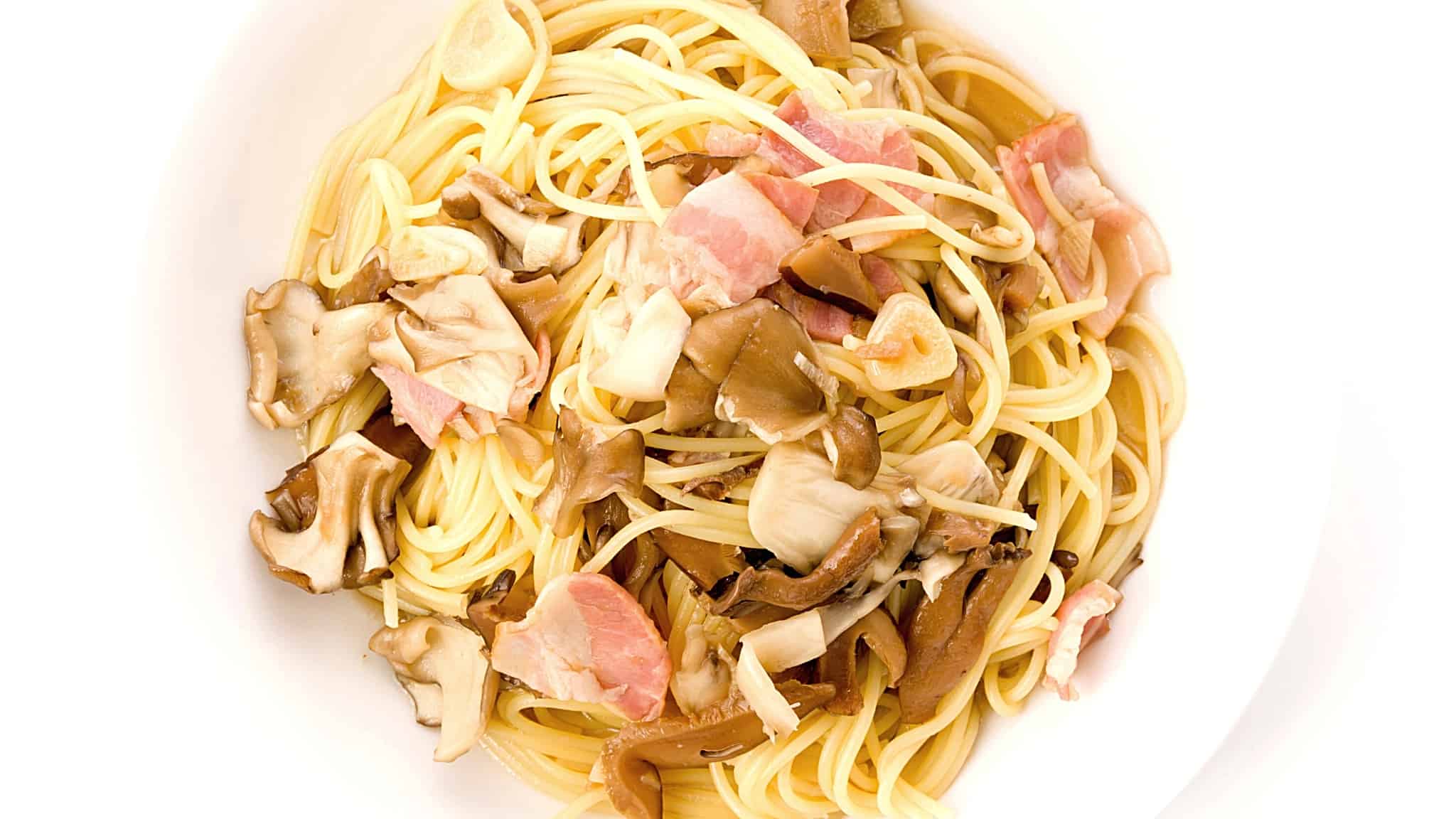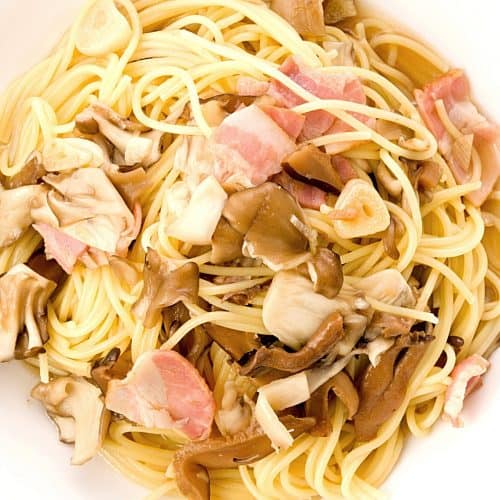Japanese style mushroom pasta recipe: deliciously creamy butter soy sauce pasta
Most people associate pasta with Italian food and noodles with Japanese cuisine.
But thankfully, foodies can enjoy an interesting fusion between spaghetti, Asian-style sauce, and mushrooms!
Japanese style pasta is called wafu, and it’s the food you’ve been missing all along.

I’m sharing a special recipe that sounds so simple, yet it’s full of rich, creamy textures, umami flavor, and a mix of mushrooms. It’s called butter soy sauce pasta with mushrooms.
To make the sauce, mix soy sauce, butter, pasta, and your choice of mushrooms. It sounds simple, but it’s much more delightful in taste than you’d think!

Check out our new cookbook
Bitemybun's family recipes with complete meal planner and recipe guide.
Try it out for free with Kindle Unlimited:
Read for freeIn this post we'll cover:
What is wafu butter soy pasta?
Generally speaking, Japanese wafu pasta is a tasty fusion of Western-style pasta like spaghetti, but it’s flavored with Japanese ingredients (soy sauce, dashi, mirin, etc.).
So, while it’s filling and yummy like Italian pasta dishes, the flavors lean towards “umami,” which is truly Japanese.
Butter Shoyu Pasta (バター醤油 パスタ) is a simple 3-ingredient wafu pasta dish.
It’s made by combining spaghetti pasta with a rich butter and soy sauce cream, mixed with Asian mushrooms.
It’s actually one of the most popular Japanese pasta recipes of all time.
Why?
Because you don’t need to buy fancy ingredients, and almost anyone can cook this – yes, it’s so beginner-friendly.

Butter soy (shoyu) pasta with mushrooms recipe
Ingredients
- 250 grams shiitake mushrooms
- 250 grams shimeji mushrooms
- 450 grams of spaghetti pasta
- 2 tbsp olive oil
- 3 - 4 large garlic cloves
- 4 tbsp soy sauce
- 55 - 60 grams butter about 4 tbsp
- ½ bunch parsley for garnish
Instructions
- First, you have to boil the pasta. Fill a large pot with 4-inches of water and add 2 tbsp of salt and bring it to a boil.
- Clean and wash the mushrooms, then slice them into small strips.
- Boil the pasta al dente (so that it has a firm texture).
- Grab a frying pan, add the olive oil and sautee the garlic until it’s fragrant but not burnt.
- Now add the mushrooms and sautee them until they are wilted and well-cooked but not burnt. They should brown and shrink in size.
- Add the butter into the pan and let it melt while stirring the mushrooms.
- Add in the soy sauce, stir, and add about 3 or 4 tbsp of pasta water. This makes the sauce starchy and thick.
- Drain the pasta and add it to the pan. Mix all the ingredients together. Add more pasta water until the sauce is liquidy and doesn’t feel chunky.
- Serve while hot and garnish with some parsley.
Japanese style mushroom pasta: nutritional information
A serving of butter shoyu pasta contains approximately:
- 635 calories
- 22 g protein
- 22 g fat
- 92 g carbohydrates
This is a high-fat and high-carb dish because of the butter and wheat pasta. As well, soy sauce is high in sodium.
I don’t recommend butter shoyu pasta for weight loss and dieting because one serving has a high-calorie and high-fat content.
Buttery pasta contains cholesterol, saturated fats, and sugars. As you probably know, when you think of pasta, you associate it with carbs.
Mushrooms are a low-calorie food with antioxidant properties, fiber, and protein.
Butter helps strengthen bones and helps the body convert beta carotene into vitamin A.
While this may not be the perfect diet-friendly food, it’s so delicious that the carbs are worth it.
Also read: 7 most popular Japanese mushrooms & their delicious recipes
Japanese style mushroom pasta recipe variations
Butter
Unsalted butter is a great option because you’re adding salty soy sauce.
Thus, unsalted butter ensures your not eating too much sodium. If you use salted butter, use less soy sauce so that the dish is not too salty.
Vegan
If you prefer vegan pasta, use soy butter instead of dairy butter. It will have a similar texture and flavor.
If you can find cultured unsalted butter, it’s even better because it has a creamier texture and a more intense “buttery” flavor.
Soy sauce
You can use any kind of soy sauce, including reduced-sodium varieties.
I like to use Kikkoman because it has a pleasant taste and it’s budget-friendly.
Some people prefer the stronger flavored usukuchi soy sauce, but it contains more sodium.
Read more about Kikkoman brand origin, products and style
Pasta
For this recipe, I prefer to use Italian-style spaghetti.
You can also use linguine or other long pasta. Sure, even fusilli or farfalle work, but spaghetti is the top choice for wafu style pasta.
Seasoning
This pasta doesn’t require much seasoning. All you need is garlic, but you can also add onion, spring onions, and a bit of ginger.
Mushrooms
I think the mushrooms are the most important part of this dish. The top choice is shiitake, but mixing a few varieties makes the pasta tastier.
In addition to the shiitake, you can use maitake and shimeji (beech), which are smaller mushroom varieties.
If you can’t find Japanese-style mushrooms, go for oysters mushrooms, buttons, and crimini. Look out for enoki mushrooms too, they taste great!
Vegetables
With this simple pasta, you can definitely add more vegetables to make it healthier. But, you can also just have a side salad with fresh greens.
If, however, you prefer to add veggies to the pasta, you can add corn, broccoli, potatoes, spinach, asparagus, artichoke, capers, or any leftover vegetables you have in the fridge.
Meat & protein
Butter soy pasta is more about the creamy sauce combined with mushrooms.
But, if you really crave meat, you can add some ground beef or pork, which resembles pasta bolognese texture.
Another option is bacon. Fry the bacon and cut it into small bits and mix it in with the sauce.
Seafood
Scallops, shrimp, crab, and clams are all delicious additions to butter soy sauce. Simply sear the seafood in hot oil for a couple of minutes and then add it to the sauce.
You can use some of the pasta water to dilute the sauce so you can really feel the seafood flavors come through.
Vegetarian
If you prefer a vegetarian protein source, you can also add some fried tofu pieces.
Also, once you plate the pasta, you can top it with a poached or fried egg (sunny side up).
Sous vide egg is another popular option, but you have to cook the egg at a low temperature for about one hour.
How to serve & store Japanese style mushroom pasta
Butter shoyu pasta is best served warm so you can feel that hot creamy sauce as it coats the spaghetti. Once cold, the sauce sticks to the pasta too much, and the mushrooms become mushy.
This is quite a filling dish as a result of the butter and pasta combo.
I recommend serving it with a light low carb side dish like a salad full of leafy greens with delicious miso-ginger dressing.
You can also add some grated parmesan if you want that Italian touch.
You can keep the pasta leftovers in the fridge for a day or two, but you won’t feel the same tasty creaminess you get when eating it fresh. I don’t recommend freezing this dish.
Origin of wafu pasta
Wafu pasta (和風パスタ) translates to “Japanese style pasta,” and it became widely popular in Japanese restaurants and households in the 1980s.
During that decade, Japan experienced an influx of Italian recipes.
At that time, Western-style pasta dishes became widely popular, and people started experimenting with combinations of Asian & European flavors.
However, wafu pasta has a history of about 100 years, but it just never managed to outshine noodles and rice dishes.
During the late 1800s, as people traveled around the world, they imported all kinds of foreign dishes, and spaghetti made its way to Japan.
It was common practice to add the ingredients you add to rice dishes but swap the rice with pasta.
And thus, butter soy pasta with shiitake mushrooms was born sometime in the 1990s.
Read more: Ramen vs Pasta Noodles: differences in uses, nutrition & more
Bottom line
When you just don’t know what to have for dinner, look around the pantry and fridge and gather some basics. This recipe is perfect for those busy weeknights when you a quick dinner.
You don’t even have to buy expensive Japanese mushrooms and just use any type you have.
What makes this such a great basic recipe is that you can make upgrades and add whatever tasty ingredients you have in your kitchen.
Here’s another delicious Asian pasta recipe: Filipino chicken macaroni salad recipe with condensed milk
Check out our new cookbook
Bitemybun's family recipes with complete meal planner and recipe guide.
Try it out for free with Kindle Unlimited:
Read for freeJoost Nusselder, the founder of Bite My Bun is a content marketer, dad and loves trying out new food with Japanese food at the heart of his passion, and together with his team he's been creating in-depth blog articles since 2016 to help loyal readers with recipes and cooking tips.
